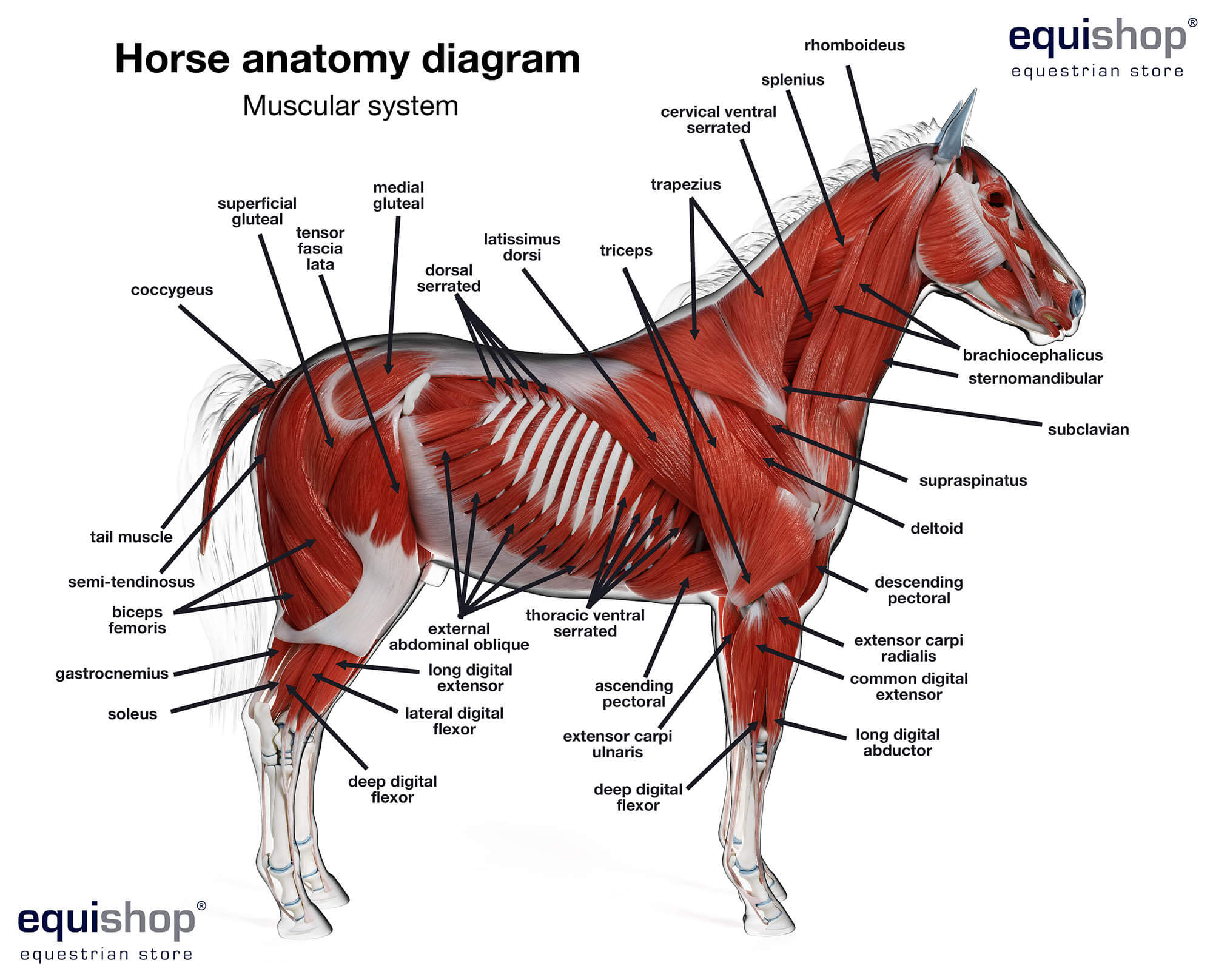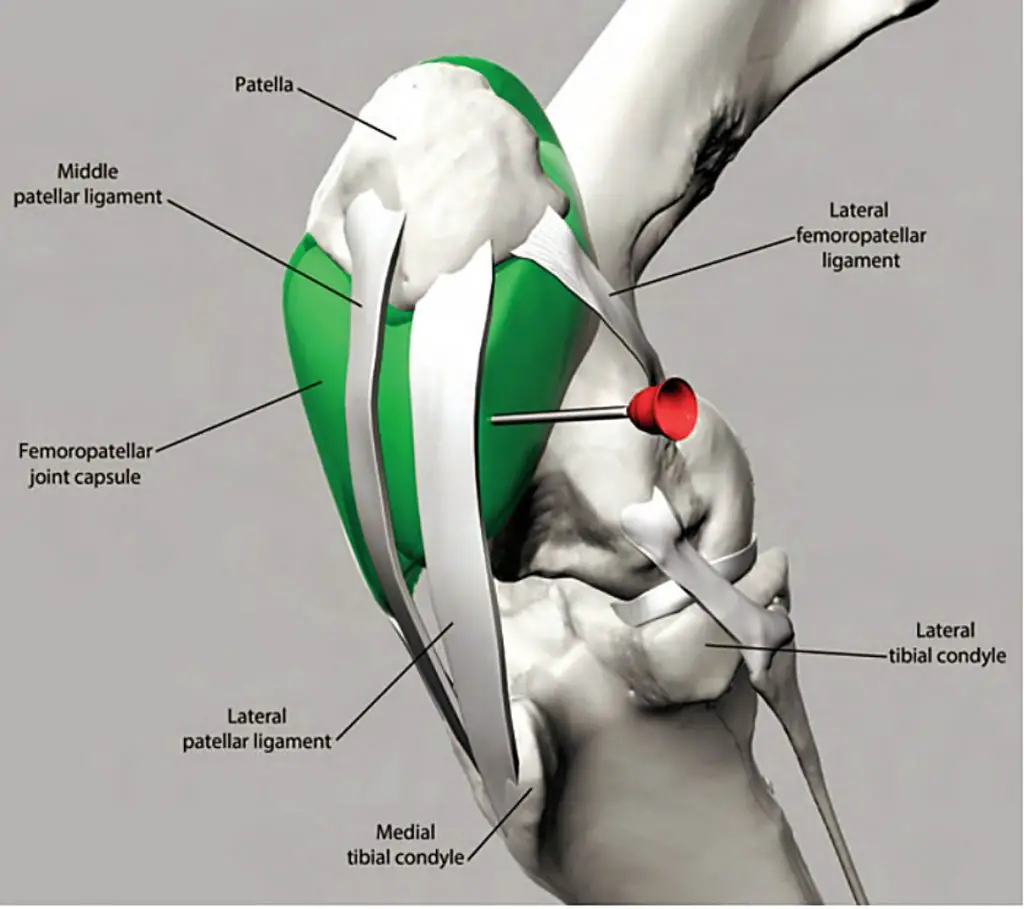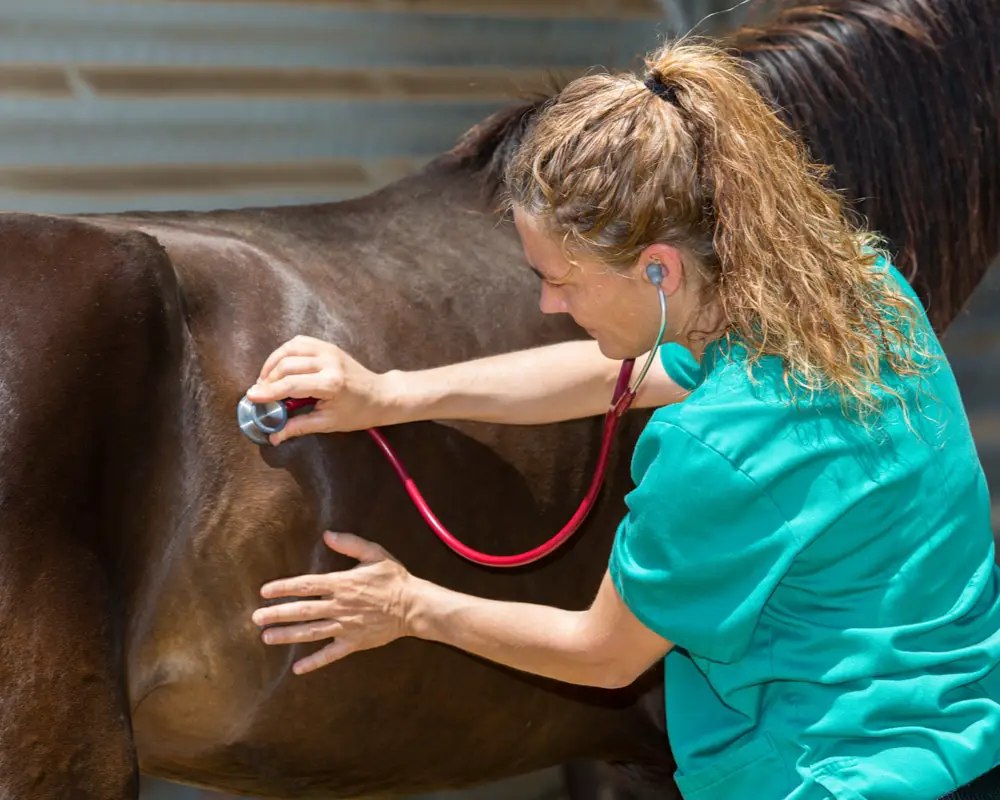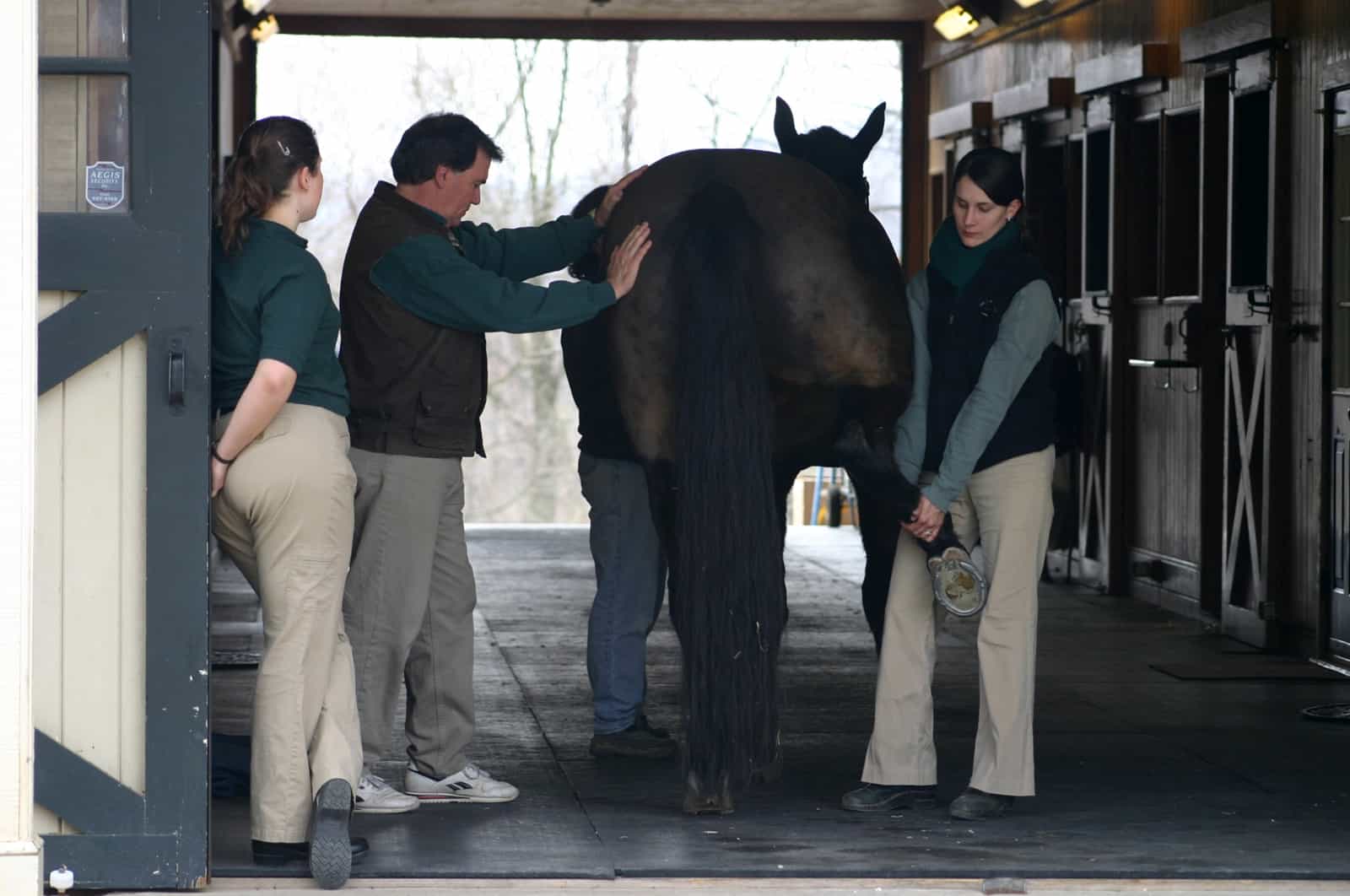Understanding the stifle on a horse is crucial for diagnosing issues, providing proper care, and ensuring the longevity and health of these magnificent animals. Situated in the hind leg, the stifle joint in horses is a key player in their remarkable mobility and strength.
The stifle is the largest joint in the horse’s body, found where the femur meets the tibia in the hind leg. It allows for the flexion and extension necessary for movement, comparable to the human knee. Here are the key points to know:
- Equine stifle location: Between the femur and tibia in the hind leg.
- Function: Enables flexion and extension, crucial for stability and mobility.
- Similarity to human anatomy: Comparable to the human knee joint.
- Common issues: Includes arthritis, bone cysts, and ligament injuries.
Exploring the Horse’s Stifle: Anatomy and Care

A detailed understanding of the equine stifle location is essential for those involved in horse care and treatment. Profound knowledge of this area aids in maintaining equine health and identifying potential complications. The stifle, a critical component of the horse hind leg anatomy, plays an integral role in the animal’s ability to perform everyday activities, including walking, running, and jumping. A deep understanding of this anatomy enhances our ability to provide quality care for these animals.
Understanding the Stifle’s Complex Structure
The stifle is not merely a singular joint but a hub where various skeletal and soft tissue structures meet. This joint acts as a pivot, crucial for thrust and load bearing, and its health is essential for the horse’s overall functionality and athletic capabilities.
Detailed Anatomy of the Stifle Joint
- Composition: The stifle encompasses the femur, tibia, patella, menisci, and associated ligaments, forming a sophisticated support system.
- Movement Mechanics: Its unique configuration allows for an extensive range of motion, essential for the horse’s diverse locomotive needs.
- Supportive Structures: Muscles and soft tissues around the stifle provide additional stability to endure the stress of equine activities.
Guidelines for Locating the Stifle
To adeptly locate the stifle, one should visually inspect the hindquarters, following the leg’s anatomy to discern the stifle’s characteristic prominence. This competency is key for the early identification of any unusual conditions.
Recognizing Stifle Disorders
An intricate understanding of the stifle’s functioning is required to recognize potential disorders. These can vary in severity and influence the horse’s well-being and performance. Early detection and treatment are critical components of equine care.
Preventive Measures for Stifle Health
Protecting the stifle involves regular veterinary examinations, exercise programs tailored to the horse’s needs, and attentive observation for any signs of discomfort or changes in gait.
The Stifle’s Relationship with Adjacent Joints
The stifle functions within a network of joints, including the hip and hock, that collectively support movement. Holistic care of the equine musculoskeletal system is vital for the prevention and treatment of compensatory issues that may stem from stifle problems.
Comprehensive Stifle Management
Effective stifle care encompasses thorough evaluations, exercise regimens designed to strengthen the joint, and staying informed about the latest developments in equine orthopedic health to enhance treatment and rehabilitation strategies.
Advancing Our Knowledge of Horse Leg Joints

The intricate horse stifle anatomy showcases nature’s precise design, enabling horses to execute a variety of actions with agility and power. The stifle’s role as the principal hinge in the hind leg is central to their movement capabilities, supporting the horse’s weight and affording the leverage needed for quick movements.
Delving into the Stifle’s Constituents
- Patella: Acts as a protective shield for the joint and aids in movement.
- Menisci: Provide cushioning and joint stability.
The Interconnectedness of the Stifle’s Soft Tissues
The stifle’s functionality is enhanced by a network of soft tissues. Tendons connect muscles to bones, enabling motion, while ligaments ensure joint cohesion for stability. The menisci’s role in shock absorption contributes to the fluid motion of the horse.
Insights from Comparative Anatomy
Examining the horse leg joints highlights evolutionary developments tailored to equine requirements. When comparing stifle anatomy across species, the horse’s stifle structure is distinctively adapted to support their particular size and active lifestyle.
Unraveling Stifle Biomechanics
The stifle’s biomechanics encompass a range of movements and forces, which are orchestrated by the harmonious action of muscles and tendons. This balance is pivotal for the horse’s stable movement, particularly in high-intensity actions.
Conformation’s Influence on Stifle Wellness
A horse’s conformation can have a substantial effect on the health of its stifle joint. The alignment between the stifle and adjacent joints is essential for preventing undue wear and potential injuries.
Importance of Muscular Support
Stifle movement is initiated and safeguarded by surrounding muscles. The quadriceps and hamstrings play critical roles in extending and flexing the stifle, respectively. Ensuring these muscles are strong and balanced is crucial for stifle health.
Implications of Growth on Stifle Structure
The progression of a horse’s growth significantly influences the development of the stifle joint. Attentive management of nutrition and care during growth phases is paramount for fostering a robust stifle capable of meeting the demands of equine activities.
Advancing Equine Stifle Health

Equine athletes face physically strenuous activities that can predispose them to various ailments. Recognizing the early signs of stifle problems in horses is vital for prompt treatment and to help prevent further issues.
Spotting Early Signs of Stifle Issues
For caretakers and horse owners, awareness of initial symptoms is essential. These indicators may include:
- Changes in performance or unexpected reduction in capability
- Hind leg stiffness after periods of rest
- Discomfort or sensitivity around the stifle when palpated
- An abnormal stance with the hind legs positioned widely
Observing these signs may suggest the horse is experiencing discomfort in the stifle area.
Diverse Conditions Affecting the Stifle
A range of specific disorders can impact the stifle, each with distinctive symptoms:
- Osteochondritis Dissecans (OCD): A condition seen in young, growing horses resulting in stiffness, joint swelling, and discomfort.
- Patellar Ligament Desmitis: This inflammation can cause lameness and alter the horse’s gait.
- Meniscal Injuries: These are characterized by swelling, joint fluid accumulation, and decreased mobility.
Injury Risks Related to Stifle Structure
The stifle’s specialized structure contributes to the incidence of certain injuries. Due to its critical weight-bearing role and involvement in complex movements, the stifle is prone to stress injuries. The stifle’s ligaments are under constant tension, unique compared to the human knee, predisposing them to specific issues such as upward fixation of the patella (UFP), which can immobilize the leg.
Activities Heightening Stifle Injury Risk
Certain actions can increase the likelihood of stifle injuries. These include:
- Improper jumping techniques or excessive jumping
- Missteps or falls on uneven terrain
- Abrupt stops and pivots that exert additional stress on the joint
Factors Influencing Stifle Health
Environmental and genetic elements can also affect the risk of developing equine stifle issues:
- Suboptimal footing conditions that induce unstable joint movements
- Inherited conformational defects that can predispose horses to extra stifle strain
- Improper exercise routines that might weaken or overstrain the stifle’s structures
Complexities of Stifle Disorders
While physical exertion is a common cause of stifle problems, certain pathologies may stem from other diseases like Lyme disease or systemic conditions such as equine metabolic syndrome. These can have indirect effects on stifle function, leading to atypical gait and lameness.
Addressing Stifle Conditions Proactively
When a stifle condition is suspected, proactive measures include:
- Halting activities that might worsen the condition
- Seeking a veterinarian’s expertise to accurately diagnose the problem
- Creating a custom rehabilitation plan after diagnosis
A proactive approach is crucial in addressing stifle problems in horses, alleviating discomfort, and facilitating recovery.
Enhancing Diagnosis of Stifle Ailments in Horses

Proficiently identifying stifle ailments in horses is paramount for their welfare and athletic potential. A blend of observant clinical analysis and cutting-edge diagnostic methods is fundamental to discerning and addressing these intricate equine stifle issues.
Key Indicators of Potential Stifle Dysfunction
Attentiveness to subtle behavioral and physical cues can often illuminate the onset of stifle dysfunction. Caregivers should monitor for:
- A noticeable decline in performance or avoidance of typical activities
- Apparent discomfort during gait changes or executing maneuvers
- Asymmetrical weight bearing that might suggest stifle discomfort
- Persistent swelling or warmth near the stifle joint post-exercise
These signs warrant a deeper examination to ascertain the existence and extent of stifle complications.
Employing Modern Diagnostic Tools for Stifle Challenges
Upon suspecting stifle afflictions, veterinarians employ various diagnostic instruments to accurately diagnose the condition:
- X-ray Imaging: Provides critical insights into bone health, helping to identify fractures and arthritis-related changes.
- Sonography: Offers detailed views of the stifle’s soft tissues, crucial for evaluating ligament and tendon conditions.
- MRI: While not as commonly utilized due to cost, MRI gives an all-encompassing image of both bony and soft tissue structures.
- Scintigraphy: A technique useful for detecting subtle bone stress not visible on standard X-rays.
- Arthroscopic Examination: Allows direct inspection and potential treatment of the stifle’s internal mechanisms.
These diversified diagnostic measures help in crafting a specific and effective treatment strategy.
Conducting Lameness Examinations to Evaluate the Stifle
An essential aspect of stifle evaluation is the thorough analysis of lameness, which may involve:
- Utilizing technology for precise gait assessment
- Performing flexion tests to intensify and pinpoint discomfort
- Applying nerve blocks to accurately determine the locus of pain in the stifle region
These evaluations not only validate the involvement of the stifle but also gauge the degree of its impact on the horse’s mobility.
Supplementary Laboratory Insights for Stifle Diagnosis
Lab tests complement imaging to fortify the diagnostic process:
- Blood work can reveal systemic conditions that might be contributing to stifle dysfunction.
- Examining joint fluid extracted through arthrocentesis can offer valuable information on the joint’s health status and any underlying trauma or infection.
These additional tests augment the veterinarian’s diagnostic arsenal for managing stifle conditions.
Integrating Observations and Test Results for Accurate Diagnosis
The expertise in diagnosing stifle issues stems from blending clinical signs with diagnostic evidence. Skilled veterinarians combine:
- The horse’s clinical history with observable symptoms
- Findings from physical and lameness examinations
- Data from diagnostic imaging and lab tests
This integrated diagnostic process fosters a well-rounded perspective on the stifle’s health, guiding subsequent treatment decisions and care plans.
Comprehensive Approaches to Stifle Rehabilitation

Restorative treatment for equine stifle disorders requires a combination of rest, medication, and sometimes surgery to alleviate discomfort and facilitate recovery. In addition to these approaches, supportive therapies and nutritional supplements are integrated to meet the joint’s specific needs and enhance healing.
Initial Treatment Steps for Stifle Challenges
Primary care for stifle challenges typically includes rest to allow for recovery from injuries or stress. Anti-inflammatory medications are often prescribed to minimize inflammation and pain. Surgical options are considered for serious cases to address tissue damage, all under the guidance of an experienced equine veterinarian to ensure the treatment plan is optimized for the horse’s individual situation.
Complementary Supportive Therapies
Equine therapy has expanded to include innovative treatments that support stifle recovery:
- Laser Therapy: Promotes cell renewal and blood flow through directed light energy.
- Hydrotherapy: Utilizes water exercises for muscle strengthening with minimal joint impact.
- Physical Therapy: Aids in restoring joint movement and muscle strength around the stifle.
- Chiropractic Adjustments: Focuses on alignment to improve musculoskeletal balance.
- Acupuncture: Offers pain relief and stimulates healing.
Supplemental Support for Stifle Joints
Dietary supplements known as nutraceuticals, including glucosamine and MSM, are employed to promote cartilage repair and mitigate inflammation. The effectiveness of these supplements may differ, but they are frequently part of a holistic treatment plan, with numerous reports of beneficial effects.
Blending Treatment Methods for Optimal Recovery
Employing a mix of therapeutic options can lead to the most effective recovery from stifle conditions. An integrated care program might include:
- Prescribed medications for initial pain relief after trauma.
- Gradual integration of supportive therapies such as laser or water-based exercises as the horse starts to regain movement.
- Exercise programs tailored to fortify the stifle, avoiding excessive strain.
- Nutraceuticals to maintain joint health over the long term.
This comprehensive approach aims to heal current issues and forestall future ones.
Personalized Recovery Strategies
Due to the distinct nature of each horse and stifle condition, tailored rehabilitation strategies are essential. These strategies typically encompass:
- Evaluating the horse’s overall health and the extent of the stifle condition.
- Setting achievable recovery objectives based on various factors, including age and activity levels.
- Consistent monitoring and adjustment of treatment protocols according to the horse’s response.
Such individualized care ensures the most effective recovery and return to activity.
Post-Treatment Preventive Measures
Averting a recurrence is critical in stifle care. After treatment, the focus shifts to preventive measures, which include:
- Ongoing vigilance for signs of pain or gait abnormalities.
- An exercise regimen that strengthens without overburdening the stifle.
- Routine veterinary examinations to preemptively manage any minor issues.
Adopting these practices is crucial for the sustained health and competitive fitness of horses post-stifle treatment.
Advancing Stifle Joint Health in Equines

Ensuring the health of the stifle joint is essential for a horse’s overall well-being and performance. A comprehensive approach that emphasizes preventative measures is key to reducing injury risks and promoting joint durability. By integrating exercise, nutrition, and attentive care, the goal is to keep the stifle joint in prime condition, supporting the horse’s athletic activities and minimizing the occurrence of injuries.
Proactive Measures for Stifle Joint Preservation
Preventing injuries to the stifle joint involves a series of best practices aimed at reinforcing structural integrity and functionality. These recommendations focus on:
- Regular exercise routines to develop strength and flexibility.
- Shoeing adjustments for proper limb alignment and optimal movement patterns.
- Careful monitoring of workload intensity, especially in demanding equestrian disciplines.
Nutritional Support for Reinforcing Joint Health
Nutrition is a cornerstone of stifle joint care, with specific nutrients offering targeted benefits:
- Incorporating omega-3 fatty acids to combat inflammation.
- Supplying antioxidants like vitamin E and selenium to safeguard joint tissues.
- Ensuring adequate intake of calcium and phosphorus for maintaining bone density.
Proper dietary balance or supplementation of these nutrients can significantly bolster stifle joint health over time.
Exercise Approaches to Fortify the Stifle
Select exercises can significantly enhance stifle robustness:
- Incorporating hill work to condition the hindquarters, providing stifle support.
- Utilizing Cavaletti drills to foster joint agility and coordination.
- Implementing controlled trotting sessions for muscle toning with minimal stress.
These exercises should be introduced progressively and customized to the horse’s fitness level to mitigate stifle joint strain.
Shoeing Adjustments and Surface Choices
Training surfaces and hoof care greatly affect stifle joint health:
- Steering clear of excessively rigid or slick terrains that increase injury risk.
- Ensuring hoofwear provides correct support for healthy limb dynamics.
- Maintaining hoof care practices that encourage optimal hoof structure and support.
Environmental and Lifestyle Impacts on Stifle Joint Care
Stifle joint health is influenced by various environmental and lifestyle factors:
- Prioritizing turnout time for unrestricted movement and joint lubrication.
- Providing stable conditions conducive to proper rest and recuperation.
- Modifying workloads based on the horse’s age, health status, and external pressures.
Periodic Evaluations by Veterinarians
Consistent evaluations by a veterinarian are vital for spotting any early signs of stifle joint issues. These check-ups typically encompass:
- Physical inspections to pinpoint discomfort or inflammation symptoms.
- Analyses of the horse’s gait to uncover changes hinting at joint stress.
- Customized recommendations for care, exercise, or nutrition adjustments following examination results.
Coordinated Stifle Care Strategies
Employing a variety of care strategies offers a well-rounded approach to maintaining stifle joint health:
- Balancing workout routines with adequate rest to prevent joint fatigue.
- Incorporating diverse training methods to engage different muscle groups, reducing repetitive stress.
- Adapting exercise intensity to suit each horse’s unique requirements and abilities.
Every aspect of care plays a part in fostering an environment conducive to long-term stifle joint health, ensuring the horse’s agility and strength throughout its lifetime.
Case Studies in Equine Stifle Rehabilitation
Documented cases of equine stifle injury recovery provide insight and inspiration for practitioners and horse owners alike. They highlight the resilience of these animals and the effectiveness of advanced treatment options in the field of equine rehabilitation.
Stories of Recovery and Advanced Treatments
Every stifle injury in horses is different, and recovery narratives often feature a variety of successful treatments and rehabilitation strategies, such as:
- A competitive jumper returning to form after stem cell therapy and a structured exercise regimen following a ligament tear.
- A dressage horse achieving restored joint mobility after meniscal surgery, supported by laser and hydrotherapy.
- An eventing horse resuming competition post-OCD with the help of arthroscopic intervention and a specialized recovery plan.
Recovery Prospects for Stifle Injuries
Outcomes for horses with stifle injuries depend on several factors, including the horse’s age, breed, the severity of the issue, and how quickly treatment begins. Case studies underscore that timely and individualized care often results in successful recoveries.
- Younger horses frequently experience better recovery rates due to their natural healing abilities.
- Immediate veterinary attention for stifle injuries generally leads to improved results.
- Continuous care and monitoring post-injury can significantly aid a horse’s return to its former level of activity.
Determinants of Rehabilitation Efficacy
Rehabilitation success is influenced by numerous factors, which are often highlighted in clinical case studies:
- Nature and severity of the injury
- Thoroughness and regularity of veterinary care
- Owner adherence to the treatment and rehabilitation regimen
- The horse’s general health and existing medical conditions
Rehabilitation Strategies and Long-term Joint Health
Rehabilitation strategies have been instrumental in recovery from stifle injuries, focusing on both the immediate issue and the joint’s future health:
- Physical therapy tailored to improve stifle strength and flexibility
- Conditioning programs that progressively rebuild the joint’s workload capacity
- Application of therapies like extracorporeal shockwave therapy (ESWT) for soft tissue recovery
Progressive Approaches to Stifle Injury Treatment
The future of stifle injury management is shaped by continuous advancements in veterinary medicine. Research and clinical studies are opening the door to innovative treatments that may lead to more effective outcomes:
- Research into gene therapy for enhanced healing and tissue restoration
- Development of bioresorbable implants to support the joint while minimizing surgical intervention
- Investigation into dietary adjustments to potentially accelerate recuperation and bolster joint resilience
Informed by past experiences and case studies, these forward-looking strategies offer optimism for improved rehabilitation of stifle injuries in horses.
Understanding and Managing Equine Stifle Health
Equine stifle health is a vital aspect of horse care, encompassing prevention, early detection, and effective management of issues. This section addresses common questions to empower owners and caretakers with knowledge and strategies for optimal stifle care.
Strategies for Managing Chronic Stifle Conditions
Effective management of chronic stifle conditions involves a multifaceted strategy. This may encompass scheduled veterinary assessments, long-term medication regimens for managing pain and inflammation, and exercise programs designed to preserve muscle tone while not aggravating the condition.
Exercises Beneficial for Stifle Recovery
- Ground poles: Engage the stifle joint, enhancing motion and flexibility.
- Varying terrains: Promote proprioceptive skills and stability.
- Lunging: Strengthens hindquarters with controlled exertion.
Complementary Therapies in Stifle Rehabilitation
Complementary therapies such as massage and equine osteopathy can be valuable additions to conventional treatments. They can alleviate muscle tension and boost circulation around the stifle, aiding in the joint’s overall health and comfort.
Home Monitoring Techniques for Stifle Health
At home, stifle health can be monitored by routinely checking for heat or swelling, observing movement patterns for inconsistencies, and being alert to behavioral changes that may signal discomfort or distress.
Nutritional Contributions to Stifle Wellness
Proper nutrition is crucial in supporting stifle wellness, offering key vitamins and minerals necessary for joint and bone health. A well-balanced diet, potentially augmented with joint-specific supplements, is beneficial for maintaining stifle function.
Age-Related Stifle Health Considerations
The age of a horse can influence its stifle health, with younger horses typically displaying better recovery capabilities, while older horses may endure more joint wear, highlighting the need for vigilant joint maintenance.
Addressing Breed-Specific Stifle Risks
Certain breeds may be more prone to stifle complications due to inherent genetic traits, physical conformation, or the demands of their sport. Acknowledging these breed-specific risks is important for customizing prevention and intervention plans.
Guidelines for Resuming Work Post-Stifle Injury
- Adopt a phased return-to-work protocol under veterinary supervision.
- Gradually escalate work intensity to prevent undue stress on the joint.
- Maintain prescribed therapeutic exercises and ongoing treatments.
Stifle Issues in Relation to Equine Weight
Increased weight can put more pressure on the stifle joint, possibly worsening existing conditions or heightening the risk of new injuries. Therefore, managing a horse’s weight through appropriate diet and exercise is crucial for those with stifle concerns.
Emerging Trends in Stifle Treatment Techniques
Veterinary medicine continues to evolve, bringing forth novel stifle treatment options. These advancements include regenerative therapies like PRP (Platelet-Rich Plasma) and sophisticated surgical and post-surgical care methods.
If you’re curious about different parts of a horse’s anatomy and their purposes, you might find our articles quite enlightening. For instance, learn about the essentials of horse tack by exploring what a headstall is for a horse. Or, if you’re interested in understanding more about a horse’s facial structure, our article on where the muzzle on a horse is located could be very informative. For those wondering about the upper part of a horse’s back, what a wither on a horse is will provide you with detailed insights. Each part of the horse plays a significant role in its overall health and functionality.
Conclusion: The Importance of Understanding Horse Stifle
Comprehending the intricacies of horse anatomy, particularly the understanding horse stifle, is essential for anyone involved in the care and management of horses. Knowledge of the stifle’s location, function, and potential issues enables more effective prevention, diagnosis, and treatment of stifle-related problems.
For more detailed insights into stifle injuries and treatments, refer to the Animal Therapeutics Online, which provides a comprehensive overview of this critical aspect of equine health.



